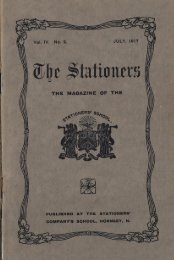You also want an ePaper? Increase the reach of your titles
YUMPU automatically turns print PDFs into web optimized ePapers that Google loves.
T h e O l d S t a t i o n e r - N o 9 0
was
asked to take over from him. Major
Anthony Lewis, formerly of the Dorset
Regiment stepped up to take over as
commanding officer temporarily, before
being confirmed in the role on 24 June and
receiving a promotion to acting-lieutenant
colonel. He remained in command until 8
August 1944, when Lieutenant Colonel
Charles Courtney-Coade of the South
Staffordshire Regiment took over, and
Lewis reverted to the role of second-incommand.
Although they had initially been told that
they would be withdrawn from the front
within 48 hours, the strategic situation
called that they remained at the front
holding the ground on the eastern flank. In
late July a breakout from the beachhead
was attempted and the 1st Special Service
Brigade moved through the Le Bois de
Bavent, a large wooded area, as the
Germans began to withdraw. Nevertheless,
little progress was made, and, after a brief
move which saw No. 6 Commando
advance to Bavent, they went on the
defensive again.
On 18 August, however, a general advance
began and the following morning No. 6
Commando took part in an attack to seize
an area of high ground to the east of the
Dives, north of Dozule. The attack took
place under the cover of darkness and the
lead elements were able to infiltrate deep
into the German positions before they were
detected. By daybreak the position had
been captured and over the course of the
day four determined counter-attacks were
repelled. In one attack, a troop from No. 6
Commando rushed their attackers, killing
the senior German officer and capturing 25
prisoners as the attack was broken up.
On 27 September the Brigade was
withdrawn to an assembly area in De
Haan, Belgium. It then prepared for
another amphibious assault, on the Dutch
island of Walcheren. The island lay at the
mouth of the Scheldt River, which ran
from Antwerp to the sea. Until the island
and the northern banks of the river were
cleared, the port could not be used to
support the Allied advance. Allied bombers
breached the dykes on 3 October at
Westkapelle, Flushing and Veere, flooding
the island, leaving only a few dry areas
around its perimeter and greatly restricting
the Germans’ freedom of movement.
The 4th Special Service Brigade formed
the seaborne element of the attack while
British and Canadian infantry attacked
overland from the mainland. This time the
commandos came ashore in Landing
41














